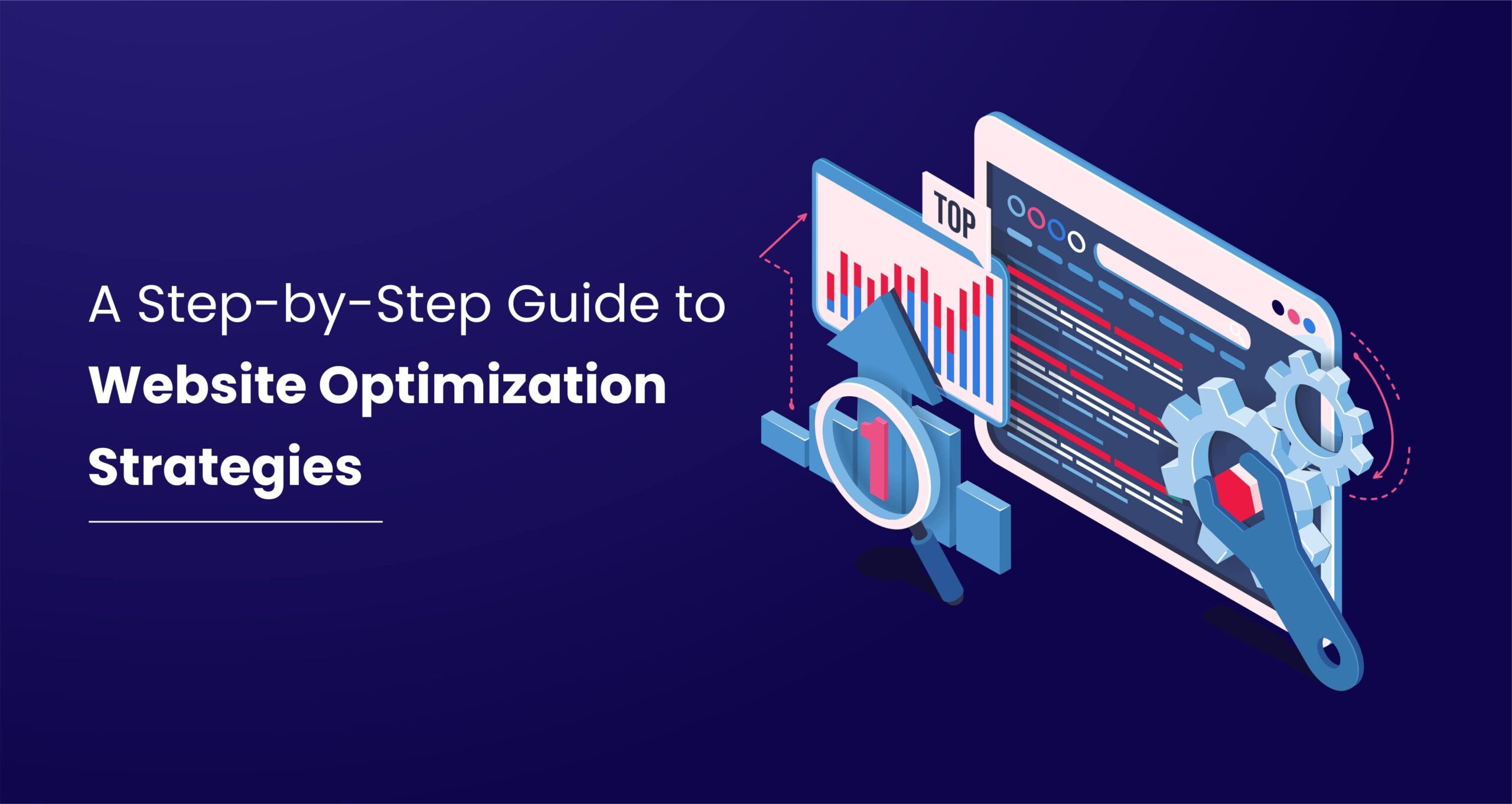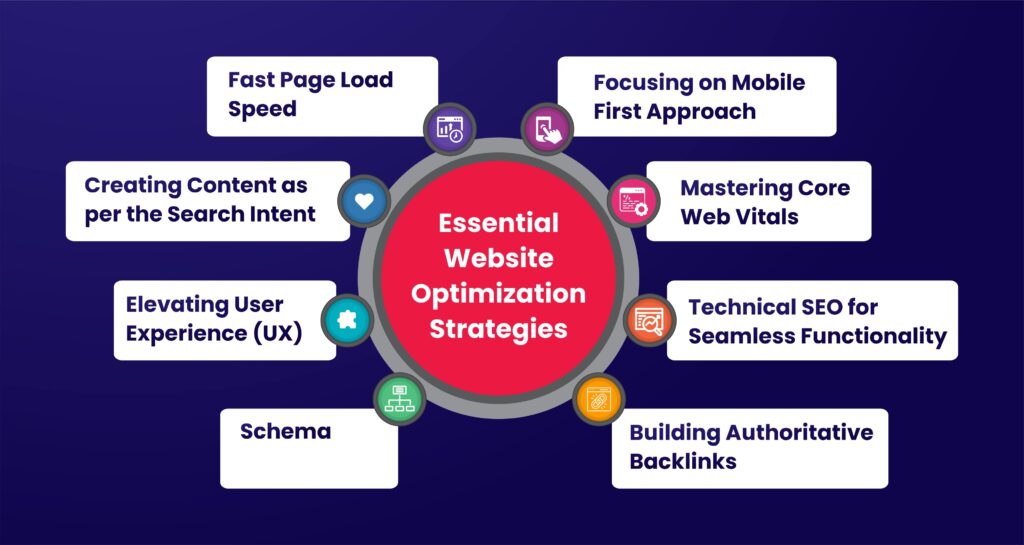
Google handles approximately 1.2 trillion result searches every year. This is not the end of the searches. If you want more people to see your content, optimizing your website can help you enhance the visibility of your business. Now if you are curious to know about why Website Optimization Strategies are crucial to find your business online?
Website optimization strategies are crucial to finding your business online because they play a pivotal role in enhancing visibility, user experience, and overall online success. To capture the interests of the customers and drive conversions, your website needs to be easily accessible to users. If the website is not easily accessible, it does not matter how much effort you have spent on creating great content. In this blog, you will understand the strategies of website optimization and contribute to higher search engine rankings and increased organic traffic.
What is website optimization?
Website optimization is a comprehensive set of actions designed to improve user experience, drive traffic, and enhance conversions on a website. In simpler terms, it is the process of refining various elements to ensure a website’s effectiveness and relevance in the digital landscape. This involves strategic efforts such as SEO (Search Engine Optimization), improving site speed, focusing on user intent, adopting a mobile-first approach, and enhancing overall technical aspects.
The goal is to create a seamless, user-friendly interface that not only attracts visitors but also retains and converts them into customers. Website optimization is a dynamic and ongoing process that adapts to evolving digital trends, ensuring that a website remains competitive and visible, and aligns with the needs of its target audience. It is a crucial component for businesses looking to establish a strong online presence and maximize their impact in the virtual space.
Why is website optimization important for Businesses to Rank Higher on Google SERPs?
Website optimization plays a pivotal role in excelling businesses to higher rankings on Google SERPs, and its significance lies in the fact that 75% of users rarely go beyond the first search engine results page (SERP). When businesses invest in optimizing their websites, they unlock the potential to attract a targeted audience actively searching for their products or services.
This targeted traffic not only increases visibility but also maximizes the generation of leads and increases sales. In a digital landscape where competition is very high, having an optimized website is the key to being visible among your targeted audience, capturing customer interest, and ensuring that businesses capitalize on the valuable opportunity presented by the first SERP to enhance their online presence and overall success.
Essential Website Optimization Strategies

In today’s digital era, having an online presence is crucial for businesses, and ensuring that your website is optimized is the key to making a lasting impact. Website optimization involves a set of strategies aimed at enhancing user experience, increasing traffic, and driving conversions. Let’s understand the essential website optimization tips and strategies that will help in increasing the leads and sales of your business.
1. Fast Page Load Speed
Imagine the scenario – you visit a website, and it takes ages to load. Frustrating, right? Page load speed is a critical factor affecting user experience. Research indicates that 40% of visitors leave a site that takes more than 3 seconds to load. For Website Speed Optimization, you need to consider some ways in which you can improve the load speed of your website:
- Minimizing image size
- Deleting unnecessary plugins
- Enabling browser caching
- Reducing server response time
- Minimizing CSS and JavaScript files
2. Focusing on Mobile-First Approach
In March 2018, Google started using a mobile-first index, which means it prioritizes mobile-friendly websites.
According to Google Search Central:
“Neither mobile-friendliness nor a mobile-responsive layout are requirements for mobile-first indexing. Pages without mobile versions still work on mobile and are usable for indexing. That said, it’s about time to move from desktop-only and embrace mobile :)”
The mobile-first approach means your website is responsive and adapts to various screen sizes. Here are some simple tips to make sure your website works well on mobile devices:
- Make your website work on any device – whether it is a computer, phone, or tablet.
- Resize your images to fit smaller screens, especially for mobile users.
- Keep your titles short. It is easier to read on mobile devices.
- Avoid pop-ups that cover your content and block visitors from seeing what your content is about.
- Remember, less can be more on mobile. Having shorter content is okay, and it does not mean you will get fewer visitors or lower rankings.
- Do not use mobile as an excuse for cloaking. Make sure both users and search engines see the same content.
3. Creating Content as per the Search Intent
As machine learning, artificial intelligence, and deep learning progress, Google relies more on these technologies in its Core Algorithm.
Google aims to grasp the context behind a search query and provide results aligned with user intent. This emphasizes the significance of advanced-level keyword research and selection to meet these evolving criteria. Did you know that almost half (46%) of all Google searches are focused on local results? Therefore, it is essential to align your thoughts with the search intent you want to target when creating content for your website.
4. Mastering Core Web Vitals
In July 2021, the Page Experience Update was introduced and is now part of Google’s core algorithm, impacting website rankings. The core web vitals initiative, focusing on essential metrics for a healthy website, aligns with Google’s commitment to providing the best user experience.
According to Google, “loading experience, interactivity, and visual stability of page content, and combined are the foundation of Core Web Vitals.” Each metric addresses a specific aspect of user experience, ensuring measurable and quantifiable results. Tools like PageSpeed Insights, Lighthouse, and Search Console help measure these core web vitals, providing insights and recommendations for enhancing website performance.
5. Elevating User Experience (UX)
User experience is all about understanding your users – what they need, what matters to them, and how they interact with your website. It also considers your business goals. Good UX practices aim to enhance the overall user experience. The key factors influencing UX include being useful, usable, desirable, findable, accessible, credible, and valuable. Your content should meet a need, your site should be easy to navigate, your design should evoke emotion, and everything should be accessible to everyone. To improve user experience, multivariate and A/B testing are effective for Website Analysis. Multivariate testing is suitable for complex changes, while A/B testing compares two different elements to see which performs better.
6. Technical SEO for Seamless Functionality
Building a strong foundation for technical SEO starts with having a well-organized website structure. You cannot just publish the random pages and posts on your website. A site with SEO-friendly architecture helps users navigate smoothly, and it is also easy for Google to crawl and index your pages.
Once your website has the right structure, it’s time to conduct a technical or SEO audit. W3Era provides various free SEO tools like keyword suggestion tools, backlink checker, page speed checker, and many more to audit your website. The key is understanding the data and knowing what to do with it.
Here are some things to check and fix:
- Look for status code errors and fix them.
- Check the robots.txt file for errors and optimize if necessary.
- Examine your site’s indexing using Google Search Console and address any issues.
- Fix duplicate title tags and meta descriptions.
- Audit your website content.
- Analyze traffic stats in Google Analytics.
- Consider improving or removing underperforming content.
- Fix broken links, as they harm user experience and possibly rankings.
- Submit your XML sitemap to Google through Google Search Console.
7. Schema
Schema markup, when incorporated into a webpage, generates a rich snippet – an enhanced description visible in search results. All major search engines, such as Google, Yahoo, Bing, and Yandex, endorse microdata usage. The true benefit of schema lies in its ability to offer context to a webpage, enhancing the overall search experience.
It is essential to note that no proof adding schema directly impacts Search Engine Results Pages (SERPs). Schema markup serves diverse purposes, enhancing web content in search results. From articles, events, and FAQs to local businesses, products, and reviews, the schema provides context for various elements. It optimizes search visibility by creating rich snippets, improving the user experience, and increasing the likelihood of attracting targeted traffic.
8. Building Authoritative Backlinks
Having good-quality links is crucial for high rankings on Google. They are more valuable than having many low-quality links. Google is now focusing more on recognizing and ignoring spammy links. With the latest updates like Penguin 4.0, it focuses on link quality.
In 2024, effective link-building strategies involve focusing on quality over quantity. Develop valuable content that naturally attracts links, engage in guest posting on reputable sites, and build relationships within your industry. Leverage social media platforms for link opportunities, participate in forums, and explore influencer collaborations. Utilize content outreach to authoritative sources and ensure your link profile remains diverse and natural. Stay informed about industry trends and algorithm changes to adapt your strategies accordingly. Remember, ethical and organic link-building practices are key to long-term success in improving your website’s visibility and authority.
By focusing on these top website optimization tips and strategies, you empower your website to thrive in the competitive digital landscape. Whether it is delivering a seamless user experience, embracing mobile responsiveness, or aligning content with search intent, these strategies form the cornerstone of a successful and optimized online presence.
Conclusion
The website optimization strategies stated above create a website that not only ranks higher but delivers a seamless and impactful user journey. W3Era professionals stand out as industry leaders, offering unparalleled expertise in delivering effective website optimization strategies as well as Website Migration Packages at budget-friendly prices. With a proven track record of success, our team combines cutting-edge techniques and in-depth knowledge to tailor strategies that precisely align with your business goals. We understand the significance of a well-optimized website in today’s competitive digital landscape and strive to enhance your online presence, drive traffic, and maximize conversions. You can choose us to elevate your website’s performance, ensuring that every optimization effort contributes to long-term success at affordable prices.
Relevant Blog:-
1. Top 7 SEO Tools For Complete Website Analysis
2. How to Increase Website Traffic
- SEO Powered Content & PR Distribution. Get Amplified Today.
- PlatoData.Network Vertical Generative Ai. Empower Yourself. Access Here.
- PlatoAiStream. Web3 Intelligence. Knowledge Amplified. Access Here.
- PlatoESG. Carbon, CleanTech, Energy, Environment, Solar, Waste Management. Access Here.
- PlatoHealth. Biotech and Clinical Trials Intelligence. Access Here.
- Source: https://www.w3era.com/website-optimization-strategies/



